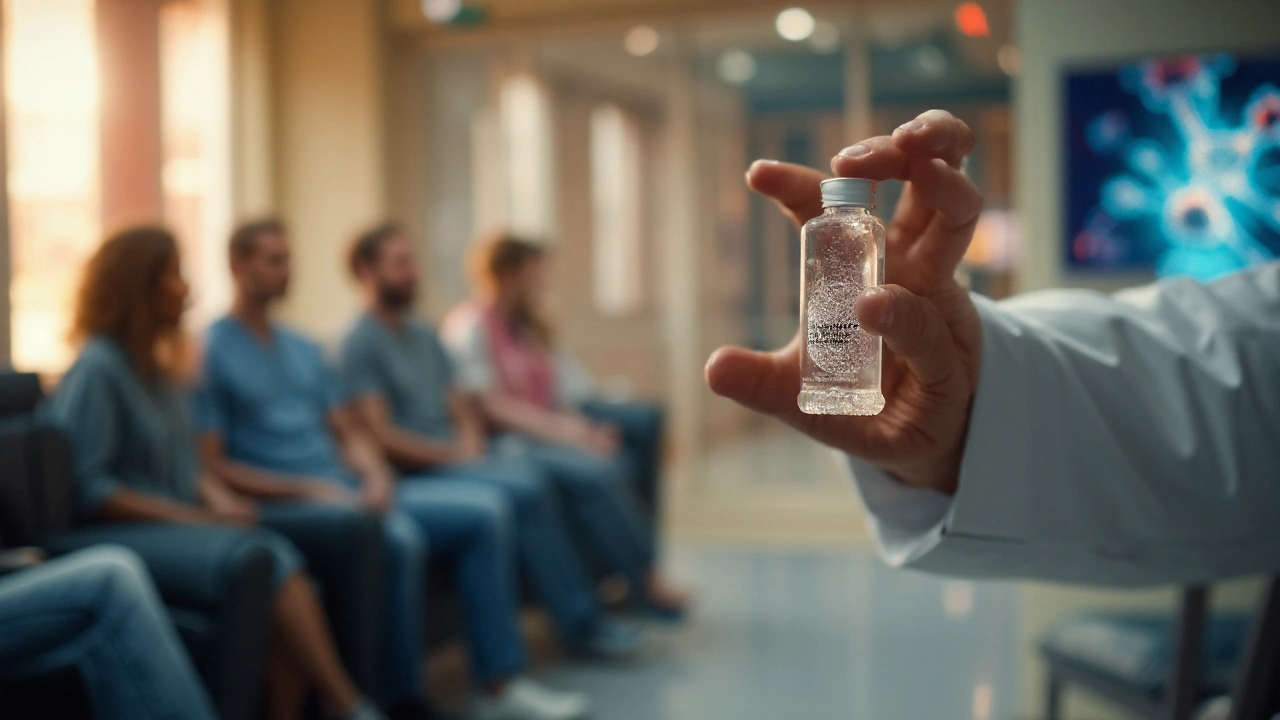Pharma Myth or Fact Quiz
Read each statement and select whether it is True or False. Click Check Answers to see your score.
1. The FDA reviews about 40 new drug applications each year.
2. Homeopathy uses dilutions that are typically less potent than a single molecule of the original substance.
3. Herbal supplements are required to have standardized dosing by the FDA.
4. A placebo effect can produce meaningful relief in chronic pain for about 30% of patients.
5. Phase III trials involve only a handful of patients.
Key Takeaways
- Pharmaceuticals are rigorously tested medicines that have measurable benefits when used correctly.
- Many health myths-herbal supplements, homeopathy, exaggerated placebo claims-lack solid scientific backing.
- Clinical trials, regulatory review, and post‑marketing surveillance are the three pillars that guarantee drug safety and efficacy.
- Understanding how evidence is gathered helps you make smarter choices at the pharmacy.
- Always weigh benefit, risk, and cost; a well‑designed study beats anecdote every time.
Pharmaceuticals are chemically formulated medicines that diagnose, treat, or prevent disease. In the United States, the FDA reviews an average of 40 new drug applications each year, with a typical development timeline of 10‑12 years and a success rate of about 12%.
What Counts as a Pharmaceutical?
In the strictest sense, a pharmaceutical is any substance that has passed a series of regulatory checkpoints-pre‑clinical animal studies, PhaseI‑III human trials, and a final safety‑efficacy assessment. These drugs can be prescription‑only, like insulin, or over‑the‑counter, like ibuprofen. Their key attributes include active ingredient concentration, pharmacokinetic profile (how the body absorbs and clears the drug), and a documented therapeutic index (the margin between effective dose and harmful dose).
Common Myths That Compete With Real Medicines
Every year, headlines scream about miracle cures that never pass a double‑blind test. Below are the most frequent contenders.
Herbal supplements are plant‑derived products marketed for health benefits. Unlike regulated pharmaceuticals, they often lack standardized dosing; a 2023 survey found that 45% of U.S. adults used an herbal product in the past year, yet only 12% could name the exact active dose they consumed.
Homeopathy is an alternative system that uses ultra‑diluted substances-typical dilutions reach 30C (10⁻⁶⁰). Scientific reviews consistently show no plausible mechanism of action, and meta‑analyses of randomized trials report effect sizes indistinguishable from placebo.
Placebo effect describes a physiological response triggered by an inert treatment. Studies on chronic pain report that around 30% of participants experience meaningful relief from a sugar pill, but this relief vanishes once the expectation fades.
These myths thrive because they are cheap, feel “natural,” and are often promoted through anecdotal social media posts. The danger lies in substituting them for drugs that have proven, quantifiable benefits.
How We Know a Drug Works: The Evidence Pipeline
The gold standard is the randomized, double‑blind, placebo‑controlled trial. In a typical PhaseIII study, thousands of patients receive either the investigational drug or an identical‑looking placebo; investigators track outcomes like mortality, symptom reduction, or biomarker changes.
Key performance indicators include:
- Effect size (e.g., a 20% drop in systolic blood pressure)
- Number needed to treat (NNT) - the number of patients who need the drug for one to benefit.
- Adverse event rate - serious side‑effects per 1,000 patients.
When the data pass predefined statistical thresholds (p<0.05) and the safety profile is acceptable, regulatory agencies grant approval.
Regulatory agencies such as the U.S. Food and Drug Administration (FDA) and the European Medicines Agency (EMA) evaluate drug applications. In 2024, the FDA approved 53 new molecular entities, each undergoing an average of 12years of review and costing roughly $2.6billion to develop.

Real‑World Effectiveness: Case Studies
Consider the anti‑viral drugremdesivir, approved for COVID‑19 treatment. In a large, open‑label trial involving 2,600 patients, the drug reduced median hospital stay by 2days compared with standard care-a modest but measurable benefit that aligns with the drug’s mechanism of inhibiting viral RNA polymerase.
Contrast this with a popular herbal supplement, ginkgo biloba, touted for memory enhancement. A 2022 meta‑analysis of 21 randomized trials (total n=5,800) found no statistically significant improvement on standardized cognitive tests, despite widespread consumer use.
These examples illustrate why the “works” label must be attached to data, not hype.
Safety Nets: Pharmacovigilance and Post‑Marketing Surveillance
Even after approval, drugs continue to be monitored. The FDA’s Adverse Event Reporting System (FAERS) collected over 1.5million reports in 2023 alone. When a signal emerges-say, an unexpected cardiac arrhythmia linked to a new antihistamine-regulators can issue safety communications, label updates, or even market withdrawals.
Vaccines provide a clear illustration of this system in action. The seasonal flu vaccine’s efficacy ranges from 85% to 95% in preventing severe disease, and rare side‑effects (e.g., anaphylaxis at 1‑2 per million doses) are tracked rigorously.
Vaccines are biologic preparations that stimulate the immune system. Global surveillance networks, coordinated by the World Health Organization, monitor adverse events in real‑time, ensuring that risk remains far below the disease burden they prevent.
Comparing the Landscape: Pharmaceuticals vs. Myths
| Category | Scientific Evidence | Regulatory Oversight | Typical Benefit (NNT) | Common Risks |
|---|---|---|---|---|
| Pharmaceuticals | Randomized controlled trials, meta‑analyses | FDA, EMA, WHO pre‑approval & post‑marketing | 2‑20 depending on condition | Adverse drug reactions, drug‑drug interactions |
| Herbal supplements | Often observational, limited RCTs | Minimal (DSHEA, not FDA‑approved) | Variable/unknown | Contamination, variable potency |
| Homeopathy | Placebo‑controlled trials show no effect | None (regulated as food) | None | Delay of effective treatment |
| Placebo effect | Documented in up to 30% of pain studies | Not a product, no regulation | Subjective symptom relief | Transient, no disease modification |
Making Informed Choices at the Pharmacy
When you walk into a drugstore, ask yourself three quick questions:
- Is there a peer‑reviewed, randomized trial backing this claim?
- Has a reputable regulatory body (FDA, EMA, WHO) evaluated the product?
- Do the documented benefits outweigh the known risks for my specific condition?
If the answer to any of these is “no,” consider switching to a drug that meets all three. Remember, a well‑studied pharmaceutical may have side‑effects, but those are quantified, managed, and continuously reviewed.
Related Concepts and Next Steps
Understanding the landscape of medicines opens doors to deeper topics:
- Pharmacogenomics - how genetic variation influences drug response.
- Drug repurposing - discovering new uses for existing pharmaceuticals.
- Antimicrobial stewardship - curbing antibiotic resistance.
- Health literacy - empowering patients to evaluate claims.
Each of these fits under the broader umbrella of evidence‑based medicine, while the current article serves as a practical entry point for anyone wading through health hype.

Frequently Asked Questions
Do herbal supplements work better than prescription drugs?
Most herbal products have not undergone the rigorous testing that prescription drugs do. While some may contain beneficial compounds, their dosing, purity, and clinical efficacy are often unknown. In head‑to‑head trials, standard pharmaceuticals usually show superior, reproducible outcomes.
Can the placebo effect replace real medication for chronic pain?
Placebo‑induced relief is real but typically modest and short‑lived. Chronic pain conditions often require pharmacologic intervention to achieve lasting control. Using placebo alone may delay effective therapy and worsen outcomes.
Why are homeopathic remedies sold in pharmacies?
In many countries, homeopathy is classified as a traditional or complementary product, not a drug. Therefore, it bypasses the strict FDA approval process. The lack of evidence means these products provide no measurable therapeutic benefit beyond placebo.
How does the FDA decide if a new drug is safe?
The agency reviews pre‑clinical data, three phases of human trials, and the drug’s manufacturing processes. It checks for statistically significant efficacy, a favorable risk‑benefit profile, and consistent quality. After approval, adverse events are monitored through FAERS.
Are vaccines considered pharmaceuticals?
Yes. Vaccines are biologic pharmaceuticals designed to stimulate immunity. They undergo the same rigorous clinical testing and regulatory review as other drugs, though their manufacturing involves living cells rather than synthetic chemistry.
What is the “Number Needed to Treat” and why does it matter?
NNT is the number of patients who must receive a treatment for one to benefit compared with a control. A low NNT (e.g., 2‑3) indicates a highly effective therapy, while a high NNT (>50) suggests limited clinical impact.

